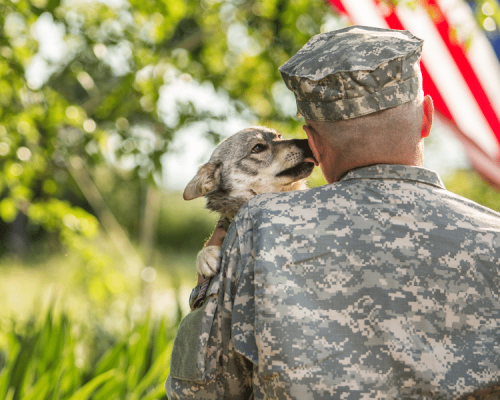Our furry four-legged friends play so many different roles in our lives. Did you know that there are dogs serving in the military alongside their handlers overseas and at home? We didn’t either! Today, March 13th, is the perfect day to recognize them because it’s K-9 Veteran’s Day. We’re shining a spotlight on how our canine companions keep us safe. These working dogs are indispensable to all the branches of the military that they serve in with their units. The handlers and dogs are partners in service.

How are Military Dogs Chosen?
While dogs have served alongside human soldiers for centuries, they serve in many capacities. The Department of Defense has a breeding program for the working dog program but puppies can be selected from civilian breeders as well. At one year old, they’re selected for training. Working dog candidates go through their own form of boot camp that lasts 120 days. Only 50% of them get to graduate and serve with a handler. Military dog handlers also go through their own intense training and are paired together as a team. Both dogs and their handlers are valuable to their units. They must have a deep and intimate knowledge of each others’ signals to work in sync with each other.
What do Military "Working Dogs" Do?
The working dogs serve in different capacities. All are trained in sniffing/detecting either explosives or narcotics. This is helpful, especially in combat situations where IEDs (improvised explosive devices) are common. In fact, due to how warfare has changed, there is specialized training for dogs to detect IEDs. Dogs are able to be trained to detect such sensitive chemicals because they have a sense of smell fifty times stronger than a human. What these working dogs detect with their nose can be used as legal evidence, so dogs must remain certified in their sense detection. “… the dog must maintain, at a minimum, 95 percent accuracy to pass the certification.”
Working dogs go on patrols, act as sentries, and yes, they’re even trained to attack if needed. Some working dogs are even trained to be parachuted or ride in helicopters. Military dogs even serve in similar ways as their fellow civilian dogs such as service or therapy dogs in hospitals. The duties of military working dogs are evolving as the landscape of the modern military changes as well.

History of Working Dogs
The US didn’t have an official force for training military working dogs until World War II. Some European countries started using military dogs earlier in the first World War. While there wasn’t an official working dog program before that time, there are stories of heroic dogs throughout history, such as with Sallie who kept the morale high during the Civil War. Today there is a monument to her in Gettysburg National Military Park as a tribute to Sallie’s bravery.
The use of military working dogs became much more widespread during the Vietnam War. “An estimated 4,000 dogs and 9,000 military-dog handlers served in Vietnam.” They were seen as such a threat by the Viet Cong who placed bounties on the dogs’ capture. Unfortunately, once the conflict was over these dogs weren’t considered as the valuable service members that they were. Many didn’t make it back to the United States after the withdrawal. Due to the backlash over this lamentable treatment, laws were passed in 2000 to give civilians and law enforcement agencies the ability to adopt these dogs and give them a life after service.
How to Recognize K-9 Veteran's Day
Like their human veteran counterparts, we can pay respects and appreciate the dogs who have served in the military in many ways. There is a National War Dogs Memorial located in Holmdel, New Jersey. The monument’s statue is of a Vietnam War veteran with his working dog. There is also a National Monument located at Lackland Air Force Base in San Antonio, Texas where all the working dog training occurs. If you’re in the area of either one of these memorials, pay a visit and express gratitude to our K-9 veterans.
Private citizens can now adopt a military working dog if the dog can no longer serve due to an injury or their age. There are a few behavioral tests the dogs must pass to be suitable for adoption. But what an incredible way to honor the dogs that keep us (and their fellow veterans) safe. These dogs deserve a joyful retirement and for us to show gratitude to these heroes.

